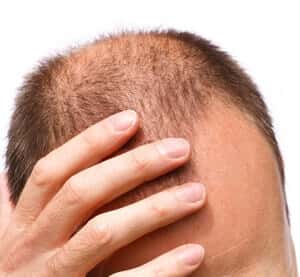
When you think about checking for heart disease what probably comes to mind are expensive exams such as stress tests on a treadmill while hooked up to a high-tech electrocardiogram, cardiac catheterization or a coronary calcium CT scan. But a low-tech inexpensive look in the mirror may be more revealing than you ever imagined.
A new study just published in the journal BMJ Open suggests that hair loss on the crown of the head might be an indicator of underlying heart disease. The investigators pooled data from six prior observational studies. A receding hair line was less problematic than baldness on the top to rear of the head (crown or “vertex” of the head). The increased risk was not huge (30 to 50%) but it was statistically significant. “Frontal” baldness was not linked to heart disease.
Another signal of heart disease may be an earlobe crease. Here is a link to see what it looks like. Researchers have been noticing an association between an earlobe crease and heart disease for nearly 40 years. The most recent report of a link came from the American Heart Association Meetings last fall. Danish investigators analyzed data from more than 10,000 volunteers participating in the Copenhagen Heart Study. Baldness on the top of the head and earlobe creases were associated with heart disease. Fatty deposits around the eyes were an additional signal of possible heart problems.
No one really has any good explanation for why hair loss or earlobe creases might be early warning signs of heart disease. The BMJ Open article proposes that high blood pressure, high cholesterol levels and atherosclerosis might also influence hair loss. That seems like a stretch. Another possible explanation is that insulin resistance leads to male pattern baldness and heart disease. Still another hypothesis is a pro-inflammatory condition is contributing to both hair loss and damage to artery walls in the heart. It has also been proposed that higher levels of male hormones (androgens) in the scalp and heart are the trigger underlying baldness and heart disease.
The Bottom Line:
What’s a man to do if he has both baldness at the crown of the head as well as earlobe creases? First, do not freak out. But if you have any symptoms of heart disease such as chest pain or shortness of breath after exercise, do check in with your doctor for more extensive testing. Do discuss your risk factors with your doctor. Finally, use these “markers” as a wakeup call to exercise, eat right and generally clean up your act. It would be great if we all take advantage of the “mirror test” opportunity to improve our health.
To learn more about some important steps you can take for heart health check out our book Quick & Handy Home Remedies From The People’s Pharmacy. It has some great recommendations about foods that can make a huge difference in your path to a heart healthy diet.
Here are some comments from visitors to our website about the earlobe crease connection:
“I remember when this info came out years ago. It was put in the category that honey heals wounds, cinnamon helped diabetes, keys down somebody’s back could stop nosebleed and blah, blah.
“I think that many, many old wives tales will be proven more and more.Love, love lllllove your info. I inherited mama’s copies of your books since the 1980’s.”
S.H.
“I have the crease in both ears – very prominent! Yet I do not have heart disease. I have had stress tests and also had the doctor look inside the blood vessels. No problem. So I could imagine if I had not had these tests your article would really have caused a lot of stress. I do not doubt the article but it is clearly possible to have these creases predominately in both ears and not have heart disease.”
Carl
“I definitely have heart trouble. I had by-pass surgery (5 bypasses) fifteen years ago after two heart attacks. Two years ago, I had an ICD put in. My left ear lobe has the diagonal crease but not the right ear lobe. I also have type II diabetes and low thyroid. Age: 73. I exercise, eat a Mediterranean diet, and take a ton of pills and supplements. My father and brother both had type II diabetes and died of strokes. My father died at age 79 and my brother at age 80.
“Neither of them exercised much after retirement but their diets were reasonably good. My mother died of heart failure at age 90 and did not have diabetes. She was active throughout her life and did her own housework up until a year before her death. She loved vegetables. My major issue is that I cannot tolerate statins and have cholesterol levels over 200. As a result, I am focusing on exercising, having a good social life and positive attitude, and sticking to the Mediterranean diet.”
M.V.
To learn more about what the Mediterranean diet is all about with specific food dos and don’ts, don’t forget to check out Quick & Handy Home Remedies. You will also find some delicious recipes that follow the Mediterranean approach!

